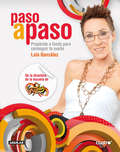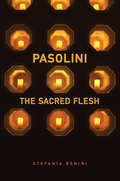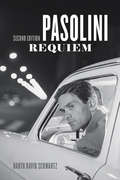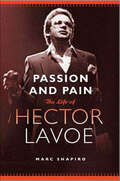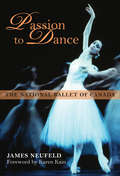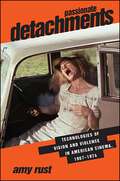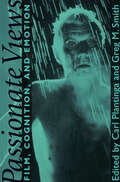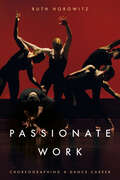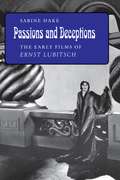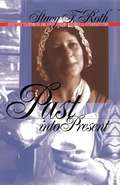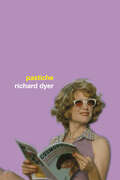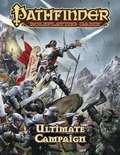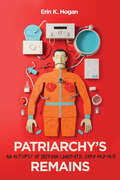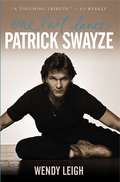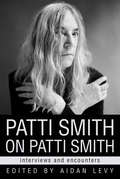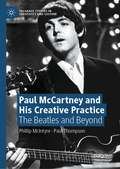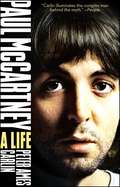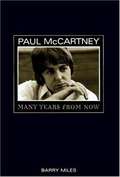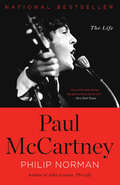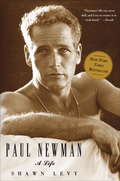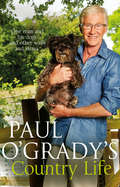- Table View
- List View
Paso a paso (Fama): Prepárate a fondo para conseguir tu sueño
by González, Lola¿Te gustaría conquistar tu sueño y no sabes por dónde empezar? ¿Fantaseas a menudo con la idea de triunfar sobre los escenarios? ¿Eres fan del programa Fama ¡a bailar! y quisieras seguir el ejemplo de alguno de los concursantes más queridos? Si harías lo que fuera por conseguir tu sueño, descubre que el secreto para alcanzarlo se esconde en tu interior. Abre bien los ojos y aprende paso a paso: - a rentabilizar tus dudas y a conocer tus limitaciones. - a cuidar tu imagen para que sea perfecta en cualquier entrevista o casting. - a valorar la importancia del trabajo y a interiorizar que la pasión y la entrega son los valores necesarios para conseguir el éxito. - a ser autodisciplinado, a escuchar, a preguntar y a trabajar en equipo. Lola González, la directora de la escuela de Fama ¡a bailar!, el programa de superación personal y de baile de más audiencia de la televisión, te ofrece en Paso a paso los mejores consejos y las anécdotas más divertidas de la escuela, y todo lo que ha aprendido como profesional de la danza y como profesora en los últimos años. Un libro divertido en el que encontrarás las herramientas necesarias para hacer realidad tu sueño.
Pasolini
by Stefania BeniniPoet, novelist, dramatist, polemicist, and filmmaker Pier Paolo Pasolini continues to be one of the most influential intellectuals of post-war Italy. In Pasolini: The Sacred Flesh, Stefania Benini examines his corporeal vision of the sacred, focusing on his immanent interpretation of the Christian doctrine of the Incarnation and the "sacred flesh" of Christ in both Passion and Death as the subproletarian flesh of the outcast at the margins of capitalism.By investigating the many crucifixions within Pasolini's poems, novels, films, cinematic scripts and treatments, as well as his subversive hagiographies of criminal or crazed saints, Benini illuminates the radical politics embedded within Pasolini's adoption of Christian themes. Drawing on the work of theorists such as Ernesto De Martino, Mircea Eliade, Jean-Luc Nancy, Alain Badiou, Giorgio Agamben, and Slavoj Žižek, she shows how Pasolini's meditation on the disappearance of the sacred in our times and its return as a haunting revenant, a threatening disruption of capitalist society, foreshadows current debates on the status of the sacred in our postmodern world.
Pasolini Requiem: Second Edition
by Barth David SchwartzPier Paolo Pasolini (1922–75) was one of the most important Italian intellectuals of the post–World War II era. An astonishing polymath—poet, novelist, literary critic, political polemicist, screenwriter, and film director—he exerted profound influence on Italian culture up to his untimely death at the age of fifty-three. This revised edition of what the New York Times Book Review has called “the standard Pasolini biography” introduces the artist to a new generation of readers. Based on extensive interviews with those who knew Pasolini, both friends and enemies, admirers and detractors, Pasolini Requiem chronicles his growth from poet in the provinces to Italy’s leading “civil poet”; his flight to Rome in 1950; the scandalous success of his two novels and political writing; and his transition to film, where he started as a contributor to the golden age of Italian cinema and ended with the shocking Salò, or the 120 Days of Sodom. Pasolini’s tragic and still unsolved murder has remained a subject of contentious debate for four decades. The enduring fascination with who committed the crime—and why—reflects his vital stature in Italy’s political and social history. Updated throughout and with a new afterword covering the efforts to reopen the investigation—and the legal maelstrom surrounding Pasolini’s demise—this edition of Pasolini Requiem is a riveting account of one of the twentieth century’s most controversial, ever-present iconoclasts.
Passion and Pain: The Life of Hector Lavoe
by Marc ShapiroA definitive biography of Hector Lavoe's rise from Puerto Rico to stardom in New York that led to sold-out concerts and best-selling salsa albums, yet gave way to drug addiction, a strained marriage and tragedy.From the poverty-stricken streets of Ponce, Puerto Rico to the vibrant barrios of New York City, HECTOR LAVOE became the singer of all singers, and the driving-force behind the Salsa movement in the mid-1960s. His popularity rivaled that of his contemporaries, Tito Puente, Celia Cruz and Johnny Pacheco.Behind the music, Hector's life was filled with drugs, alcohol and women. An endless stream of tragedy plagued him, including a gun-related accident that killed his son, Hector's ninth floor jump from a hotel window, and his death in 1993 from AIDS. But Hector's pristine voice, one-of-a-kind stage performances, sold-out concerts and bestselling albums were what his fans remember most and what made him an international icon. His music brought joy to legions of people, and it continues today.Marc Shapiro's Passion and Pain is "A no-holds barred biography" (Uptown Magazine) of a fascinating life.
Passion for the Piano
by Judith OringerEvolution of the piano, its manufacturing, care of a piano, piano competitions, the piano in literature and films, and politics and the piano.
Passion to Dance: The National Ballet of Canada
by James NeufeldThis is the story of the National Ballet of Canada – the people, the determination, and how at sixty it is still creating new work while still representing the classics. Passion to Dance is the story of the National Ballet of Canada – the people who dreamt the company into existence, the determination needed to keep it afloat, the bumps on the road to its success, and above all, its passion for dance as a living, evolving art form. From catch-as-catch-can beginnings – borrowed quarters, tiny stages, enormous dreams the National Ballet has emerged as one of North America’s foremost dance troupes. The company at sixty is a company of its time, engaged in creating challenging new work, yet committed to maintaining the classics of the past, favourites like Swan Lake, The Nutcracker,and The Sleeping Beauty. One hundred and fifty photographs from the company’s archives illustrate this definitive history, filled with eyewitness accounts, backstage glimpses, and fascinating detail. This is a record of one of Canada’s boldest cultural experiments, a book to enjoy now and keep forever.
Passionate Detachments: Technologies of Vision and Violence in American Cinema, 1967-1974 (SUNY series, Horizons of Cinema)
by Amy RustPassionate Detachments investigates the rise of graphic violence in American films of the late 1960s and early 1970s and the popular aesthetics and critical responses this violence inspired. Amy Rust examines four technologies adopted by commercial American cinema after the fall of the Hollywood Production Code: multiple-camera montage, squibs (small explosive devices) and artificial blood, freeze-frames, and zooms. Approaching these technologies as figures, as opposed to mere tools, Rust traces the encounters they mediate between perception (what one sees, hears, and feels) and representation (how those sights, sounds, and feelings make meaning). These technologies, she argues, lend shape to film violence while organizing viewers' on- and off-screen relationships to it.The result proves meaningful for an era self-consciously and perilously preoccupied with bloodshed. The post-Code period found Americans across the political spectrum demanding visual—and increasingly violent—demonstrations of presumably "authentic" realities. Corroborating fantasies of authenticity from military to counterculture, these technologies challenge them as well, pointing, however unwittingly, to the violently classed, gendered, and racialized blind spots such fantasies harbor. More broadly, the technologies answer concerns that films control violence too much or too little. Offering neither mere discourse nor mere thrills, they recover sense and sensation for all, not some, or even most, depictions of bloodshed. As figures, the devices also remediate vision and violence for film theory, which exhibits distrust for each in spite of the complexities phenomenology and psychoanalysis have brought to cinematic perception and pleasure.
Passionate Views: Film, Cognition, and Emotion
by Carl Plantinga and Greg M. SmithThe movie theater has always been a place where people come together to share powerful emotional experiences, from the fear generated by horror films and the anxiety induced by thrillers to the laughter elicited by screwball comedies and the tears precipitated by melodramas. Indeed, the dependability of movies to provide such experiences lies at the center of the medium's appeal and power. Yet cinema's ability to influence, even manipulate, the emotions of the spectator is one of the least-explored topics in film theory today.In Passionate Views, thirteen internationally recognized scholars of film studies, philosophy, and psychology explore the emotional appeal of the cinema. Employing a novel cognitive perspective, the volume investigates the relationship between genre and emotion; explores how film narrative, music, and cinematic techniques such as the close-up are used to elicit emotion; and examines the spectator's identification with and response to film characters.An impressive range of films and topics is brought together by Carl Plantinga and Greg M. Smith, including: the success of Stella Dallas and An Affair to Remember as tearjerkers; the power of Night of the Living Dead to inspire fear and disgust; the sublime evoked in The Passion of Joan of Arc, Aguirre, the Wrath of God, and The Children of Paradise; the emotional basis of film comedy as seen in When Harry Met Sally; the use of cinematic cues in Raiders of the Lost Ark and Local Hero to arouse emotions; the relationship between narrative flow and emotion in Once Upon a Time in the West and E.T.; the emotive use of music in The Elephant Man and A Clockwork Orange; Stranger than Paradise's sense of timing; desire and resolution in Casablanca; audience identification with the main characters in Groundhog Day and The Crying Game; portrayal of perversity in The Silence of the Lambs, Flaming Creatures, and Shivers; and empathy elicited through closeups of actors' faces in Yankee Doodle Dandy and Blade Runner.Passionate Views offers a new approach to our understanding of film and will be of interest to anyone fascinated by the emotional power of motion pictures and their relationship to the central concerns of our lives, as well as by the techniques filmmakers use to move an audience.
Passionate Work: Choreographing a Dance Career
by Ruth HorowitzCorps de ballet literally means the "body" of the ballet company, and it refers to the group of dancers who are not principals. Another large group of dancers puts together portfolios of work, often across several dance companies. These categories of dancers typically don't have name recognition and yet comprise the majority of professional dancers today. The ways that they stitch together careers, through dedication, grit, and no small amount of skill – and the reasons they have for doing so without the promise of fame or fortune – are telling of broader trends that shape the precarious labor of professional dance, and creative careers more generally. In Passionate Work, dance hobbyist and sociologist, Ruth Horowitz captures their stories. When creative labor is studied, it is often thought of in opposition to more conventional work, and the primary metric that distinguishes them is passion. Professional creatives are not working in the traditional sense because they are following their passion. By tracing the careers of such dancers, Horowitz troubles the binary understanding of passion and work. A career in dance requires both, and approaching her subjects through this lens allows her to explore their strategies for sustaining passion through the ups and downs of a career. Horowitz explores how dancers evaluate the rewards and challenges of a notoriously underpaid, and uncertain profession. Horowitz considers major dimensions of a career in a performing art, documenting each stage in a dancer's life. Above all, she shines a light on the strategies used to achieve a sense of biographical continuity in a world often marked by discontinuity and rupture.
Passions and Deceptions: The Early Films of Ernst Lubitsch
by Sabine HakeA collaborator with Warner Brothers and Paramount in the early days of sound film, the German film director Ernst Lubitsch (1892-1947) is famous for his sense of ironic detachment and for the eroticism he infused into such comedies as So This Is Paris and Trouble in Paradise. In a general introduction to his silent and early sound films (1914-1932) and in close readings of his comedies, Sabine Hake focuses on the visual strategies Lubitsch used to convey irony and analyzes his contribution to the rise of classical narrative cinema. Exploring Lubitsch's depiction of femininity and the influence of his early German films on his entire career, she argues that his comedies represent an important outlet for dealing with sexual and cultural differences. The readings cover The Oyster Princess, The Doll, The Mountain Cat, Passion, Deception, So This Is Paris, Monte Carlo, and Trouble in Paradise, which are interpreted as part of an underlying process of negotiation between different modes of representation, narration, and spectatorship--a process that comprises the conditions of production in two different national cinemas and the ongoing changes in film technology. Drawing attention to Lubitsch's previously neglected German films, this book presents the years until 1922 as the formative period in his career.
Past Imperfect
by Joan CollinsJoan Collins, star of films and TV, tells the story of her life. She grew up in England, married young, and several times. She had several love affairs, beautiful children, and a life many women would love.
Past into Present: Effective Techniques for First-Person Historical Interpretation
by Stacy F. RothThe portrayal of historical characters through interactive dramatization or role-playing is an effective, albeit controversial, method used to bring history to life at museums, historic sites, and other public venues. Stacy Roth examines the techniques of first-person interpretation to identify those that have been most effective with audiences while allowing interpreters to maintain historical fidelity.
Pastiche
by Richard DyerWriting with his customary wit and style, Richard Dyer argues that while pastiche can be used to describe works which contain montage or collage, it can also be used to describe works which are a kind of imitation of previous works. Investigating a wide range of cultural texts drawn from films, videos, novels, poetry, rap tracks, music and painting, Richard Dyer explores issues of text, genre, and the use of pastiche as a resource within a work. The final chapter draws together the underlying concern of the book with affect and poetics and discusses the politics of pastiche.
Pathfinder Roleplaying Game: Ultimate Campaign
by Paizo PublishingPathfinder RPG Ultimate Campaign is an invaluable addition to the Pathfinder RPG Core Rulebook. This imaginative tabletop games builds on more than 10 years of system development and an open playtest featuring more than 50,000 gamers to create a cutting-edge RPG experience that brings the all-time-best-selling set of fantasy rules into the new millennium. The Pathfinder RPG Ultimate Campaign includes: An extensive system for generating character and NPC backgrounds, history, and family, from the son of the farmer to the king's daughter; innovative new story feats that tie your character's background and experiences into the game, giving players goals to accomplish for even greater rewards; a complete system for tracking what your character does between adventures, from opening a tavern to crafting a powerful magic item; a number of systems to expand Pathfinder play, including fame, honor, relationships, and more; rules for building and maintaining a kingdom, from a small town to a mighty nation; and a simple system for taking kingdoms and larger armies to war against their neighbors or even incredibly powerful monsters, like ancient dragons or the terrifying tarrasque.
Patkatha Lekhan Ek Parichay: पटकथा लेखन एक परिचय
by Manohar Shyam Joshiपटकथा-लेखन एक हुनर है। अंग्रेजी में पटकथा-लेखन के बारे में पचासों किताबें उपलब्ध हैं और विदेशों के, खासकर अमेरिका के, कई विश्वविद्यालयों में पटकथा- लेखन के बाक़ायदा पाठ्यक्रम चलते हैं। लेकिन भारत में इस दिशा में अभी तक कोई पहल नहीं हुई। हिन्दी में तो पटकथा-लेखन और सिनेमा से जुड़ी अन्य विधाओं के बारे में कोई अच्छी किताब छपी ही नहीं है। इसकी एक वजह यह भी है कि हिन्दी में सामान्यतः यह माना जाता रहा है कि लिखना चाहे किसी भी तरह का हो, उसे सिखाया नहीं जा सकता। कई बार तो लगता है कि शायद हम मानते हैं कि लिखना सीखना भी नहीं चाहिए। यह मान्यता भ्रामक है और इसी का नतीजा है कि हिन्दी वाले गीत-लेखन, रेडियो, रंगमंच, सिनेमा, टी.वी. और विज्ञापन आदि में ज़्यादा नहीं चल पाए। लेकिन इधर फिल्म व टी.वी. के प्रसार और पटकथा- लेखन में रोजगार की बढ़ती संभावनाओं को देखते हुए अनेक लोग पटकथा-लेखन में रुचि लेने लगे हैं, और पटकथा के शिल्प की आधारभूत जानकारी चाहते हैं। अफसोस कि हिन्दी में ऐसी जानकारी देने वाली पुस्तक अब तक उपलब्ध ही नहीं थी। ‘पटकथा-लेखन: एक परिचय’ इसी दिशा में एक बड़ी शुरुआत है, न सिर्फ इसलिए कि इसके लेखक सिद्ध पटकथाकार मनोहर श्याम जोशी हैं, बल्कि इसलिए भी कि उन्होंने इस पुस्तक की एक-एक पंक्ति लिखते हुए उस पाठक को ध्यान में रखा है जो फिल्म और टी.वी. में होने वाले लेखन का ‘क, ख, ग’ भी नहीं जानता। प्राथमिक स्तर की जानकारियों से शुरू करके यह पुस्तक हमें पटकथा-लेखन और फिल्म व टी.वी. की अनेक माध्यमगत विशेषताओं तक पहुँचाती है; और सो भी इतनी दिलचस्प और जीवन्त शैली में कि पुस्तक पढ़ने के बाद आप स्वतः ही पटकथा पर हाथ आजमाने की सोचने लगते हैं।
Patriarchy’s Remains: An Autopsy of Iberian Cinematic Dark Humour (McGill-Queen's Iberian and Latin American Cultures Series #8)
by Erin K. HoganSomething is rotten in the state of Spain. The uninterred corpse of a patriarchal figure populates the visual landscapes of Iberian cinemas. He is chilled, drugged, perfumed, ventilated, presumed dead, speared in the cranium, and worse.Analyzing a series of Iberian cinematic dark comedies from the 1950s to the present day, Patriarchy’s Remains argues that the cinematic trope of the patriarchal death symbolizes the lingering remains of the Francisco Franco dictatorship in Spain (1939–75). These films, created as satirical responses to persisting economic, social, and political issues, demonstrate that Spain’s transition to democracy following the Francoist period is an incomplete and ongoing process. Within the theme of patriarchal decay, the significance of the figure differs across cinematic representations, from his indispensability to his obstructionism and exploitation. Erin Hogan traces the prevalence of patriarchal death by analyzing its relationship with the surrounding characters who must depend on the deceased. Hogan demonstrates how the patriarch’s persistence in film both reveals and challenges an array of discriminations and inequalities in the cinematic grotesque tradition, in Iberian cinemas more broadly, and in Iberian society as a whole.Despite Spain’s ongoing transition towards democratic pluralism, Patriarchy’s Remains serves as a reminder that the remnants of an entrenched although not interred patriarchal culture continue to haunt Iberian society.
Patrick Swayze: One Last Dance
by Wendy LeighA heartwarming, in-depth portrait of the beloved star whose sensational performances in Dirty Dancing and Ghost seduced a generation, and whose courage in the face of illness captivated millions For almost thirty years, Patrick Swayze has been an American icon of masculinity and sex appeal, strong but sensitive, romantic yet dangerous. In this intimate and revealing biography, New York Times bestselling author Wendy Leigh shares the inspiring untold story of Patrick's incredible life: his show business childhood, his fairy-tale love affair with wife Lisa Niemi, his catapult into alcoholism after his father's untimely death, the daredevil exploits that almost killed him, and his courageous fight against pancreatic cancer, a fight that has off-ered hope and encouragement to others grap-pling with similar life-threatening illnesses. Ever since the steamy low-budget film Dirty Dancing skyrocketed Patrick to fame and cemented his place in the hearts of audiences around the world, he has been one of our most cherished public figures. Based on interviews with countless sources who have never spoken about Patrick before -- from the Texas beauty who shared his first kiss, to the woman he almost married, to the manager who worked closely with him from his teen idol days until his romantic tour de force in Ghost -- and many more, Leigh unveils surprising details about the charismatic actor's life on- and off-screen. Beginning with his training as a dancer with his choreographer mother and spanning his remarkable -- and at times challenging -- career, this groundbreaking biography of the un-forgettable entertainer is the mesmerizing, enduring, and definitive story of a man who captured our hearts.
Patti Smith on Patti Smith: Interviews and Encounters (Musicians in Their Own Words)
by Aidan LevyFrom the moment Patti Smith burst onto the scene, chanting "Jesus died for somebody's sins, but not mine," the irreverent opening line to Horses, her 1975 debut album, the punk movement had found its dissident intellectual voice. Yet outside the recording studio—Smith has released eleven studio albums—the punk poet laureate has been perhaps just as revelatory and rhapsodic in interviews, delivering off-the-cuff jeremiads that emboldened a generation of disaffected youth and imparting hard-earned life lessons. With her characteristic blend of bohemian intellectualism, antiauthoritarian poetry, and unflagging optimism, Smith gave them hope in the transcendent power of art. In interviews, Smith is unfiltered and startlingly present, and prescient, preaching a gospel bound to shock or inspire. Each interview is part confession, part call-and-response sermon with the interviewer. And there have been some legendary interviewers: William S. Burroughs, Thurston Moore (of Sonic Youth), and novelist Jonathan Lethem. Her interview archive serves as a compelling counternarrative to the albums and books. Initially, interviewing Patti Smith was a censorship liability. Contemptuous of staid rules of decorum, no one knew what she might say, whether they were getting the romantic, swooning for Lorca and Blake, or the firebrand with no respect for an on-air seven-second delay. Patti Smith on Patti Smith is a compendium of profound and reflective moments in the life of one of the most insightful and provocative artists working today.
Paul McCartney and His Creative Practice: The Beatles and Beyond (Palgrave Studies in Creativity and Culture)
by Paul Thompson Phillip McIntyreThis book provides fresh insight into the creative practice developed by Paul McCartney over his extended career as a songwriter, record producer and performing musician. It frames its examination of McCartney’s work through the lens of the systems model of creativity developed by Mihaly Csikszentmihalyi and combines this with the research work of Pierre Bourdieu. This systems approach is built around the basic structures of idiosyncratic agents, like McCartney himself, and the choices he has made as a creative individual. It also locates his work within social fields and cultural domains, all crucial aspects of the creative system that McCartney continues to be immersed in. Using this tripartite system, the book includes analysis of McCartney’s creative collaborations with musicians, producers, artists and filmmakers and provides a critical analysis of the Romantic myth which forms a central tenet of popular music. This engaging work will have interdisciplinary appeal to students and scholars of the psychology of creativity, popular music, sociology and cultural studies.
Paul McCartney: A Life
by Peter Ames CarlinA biography of musician Paul McCartney, spanning from his years with The Beatles to his solo albums today.
Paul McCartney: Many Years From Now
by Barry MilesThis book is a history from the inside, of one of the greatest song-writing partnerships of the century. It is the private life of a man made public property - a Beatle - by the age of 21. It is the trajectory of the most popular pop group in history, from the beginnings to break-up.
Paul McCartney: The Biography
by Philip Norman'A thorough, objective telling of McCartney's story - in and out of the most famous band ever.' ESQUIREThe first biography written with McCartney's approval and with access to family members and friends closest to him.In 2013, Sir Paul McCartney granted Philip Norman 'tacit approval' as his biographer. The result is a masterly and complex portrait of the most successful songwriter in history.It gives a unique insight into McCartney's childhood, blighted by the loss of his mother when he was fourteen, and into the creative symbiosis and fierce rivalry between John Lennon and himself that powered the Beatles' music. Here, too, for the first time, is the full story of McCartney's triumphant but troubled post-Beatles years: the tragic death of his first wife, Linda, and the chaotic divorce from his second wife, Heather Mills.Paul McCartney is the definitive life of a long-misunderstood genius that superbly evokes half a century of popular music and culture.
Paul McCartney: The Life
by Philip NormanThe definitive Paul McCartney biography, written with his approval by bestselling biographer Philip Norman.Since the age of twenty-one, Paul McCartney has lived one of the ultimate rock-n-roll lives played out on the most public of stages. Now, Paul's story is told by rock music's foremost biographer, with McCartney's consent and access to family members and close friends who have never spoken on the record before. PAUL McCARTNEY reveals the complex character behind the façade and sheds new light on his childhood--blighted by his mother's death but redeemed by the father who introduced him to music. This is the first definitive account of Paul's often troubled partnership with John Lennon, his personal trauma after the Beatles' breakup, and his subsequent struggle to get back to the top with Wings--which nearly got him murdered in Africa and brought him nine days in a Tokyo jail. Readers will learn about his marriage to Linda, including their much-criticized musical collaboration, and a moving account of her death. Packed with new information and critical insights, PAUL MCCARTNEY will be the definitive biography of a musical legend.
Paul Newman: A Life
by Shawn LevyNEW YORK TIMES BESTSELLER • &“[This] absorbing, affectionate portrait manages to bring [Newman] back to us. . . . Paul Newman leaves readers with a surprisingly cheering message. If the rest of us can&’t aspire to having Newman&’s life, we can at least take inspiration from the way he lived his.&”—The Washington Post &“A graceful tribute to a one-of-a-kind man.&”—The Seattle Times&“Newman&’s life was never dull, and Levy re-creates it in vivid detail.&”—ParadePaul Newman, the Oscar-winning actor with the legendary blue eyes, achieved superstar status by playing charismatic renegades, broken heroes, and winsome antiheroes in such revered films as The Hustler, Cool Hand Luke, Butch Cassidy and the Sundance Kid, The Verdict, The Color of Money, and Nobody&’s Fool. But Newman was also an oddity in Hollywood: the rare box-office titan who cared about the craft of acting, the sexy leading man known for the staying power of his marriage, and the humble celebrity who made philanthropy his calling card long before it was cool. Unlike his father, a successful entrepreneur, Newman bypassed the family sporting goods business to pursue an acting career. After struggling as a theater and television actor, Newman landed the lead role of boxer Rocky Graziano in Somebody Up There Likes Me when, in a tragic twist of fate, James Dean was killed in a car accident. Part of the original Actors Studio generation, Newman demanded a high level of rigor and clarity from every project. The artistic battles that nearly derailed his early movie career would pay off handsomely at the box office and earn him critical acclaim.He applied that tenacity to every endeavor both on and off the set. The outspoken Newman used his celebrity to call attention to political causes dear to his heart, including civil rights and nuclear proliferation. Taking up auto racing in midlife, Newman became the oldest driver to ever win a major professional auto race. A food enthusiast who would dress his own salads in restaurants, he launched the Newman&’s Own brand dedicated to fresh ingredients, a nonprofit juggernaut that has generated more than $250 million for charity.In Paul Newman: A Life, Shawn Levy gives readers the ultimate behind-the-scenes examination of the actor&’s life, from his merry pranks on the set to his lasting romance with Joanne Woodward to the devastating impact of his son&’s death from a drug overdose. This expansive biography is a portrait of an extraordinarily gifted man who gave back as much as he got out of life—and just happened to be one of the most celebrated movie stars of the twentieth century.
Paul O'Grady's Country Life: Heart-warming and hilarious tales from Paul
by Paul O'GradyTHE SUNDAY TIMES BESTSELLERA fascinating and hilarious glimpse into Paul's life at home in the country with his animalsPaul O'Grady's Country Life for the first time gives a glimpse into the home life of one of Britain’s best loved stars, alongside the animals he adores. Sometimes rural idyll, sometimes hell on earth, Paul’s life in rural Kent has been shared over the years with some very vocal pigs, a mad cow, various rescued barn owls, the world’s most sadistic geese and Christine the psychotic sheep – among many other animal waifs and strays. And of course Paul tells the stories of the dogs in his life – including the tiny chihuahua/Jack Russell cross with Napoleonic ambitions, Eddie, Miss Olga, Bullseye, Louis, Boycie and, of course, Buster, the greatest canine star since Lassie. In addition, Paul shares some of his favourite recipes, explores country lore and superstitions, and extols the benefits of growing your own vegetables, herbs and fruit.This is a warts-and-all account of country living, as far removed from the bright lights of celebrity as you could ever imagine. The trials and tribulations Paul experienced on moving to deepest darkest Kent as a dyed-in-the-wool city dweller are every bit as hilarious and eventful as you would think. He had a lot of new skills to learn, and fast: everything from how to churn your own butter and how to birth a lamb to the best way to lure a cow out of your kitchen while naked from the waist down.Brilliantly funny and full of classic stories, Paul O’Grady’s Country Life is your armchair guide to the wonders and horrors of rural existence._____________________________Readers love Paul O’Grady’s Country Life:***** ‘This book is excellent. It will make you laugh out loud and it will make you cry.’***** ‘Delightful read. An insight into Paul O’Gradys country life, told in his true fashion. Couldn’t put it down!’***** ‘I think he has a gift of compassion for animals as well as people and it always shines through.’
